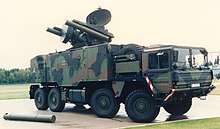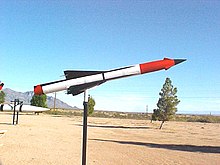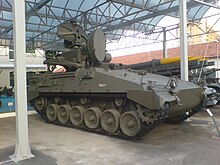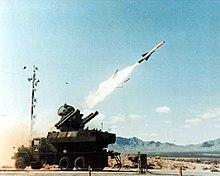Roland (weapon system)
The Roland weapon system is an all-weather capable, autonomous and ECM- resistant anti-aircraft missile system developed in the 1970s in a German - French cooperation for combating deep and deep-flying aircraft.
commitment
In the German Federal Armed Forces which was air defense system in different versions of the material responsibility of the Army used by all three sub-forces: the host 1981 as the anti-aircraft missiles tank (FlaRakPz, also: FRP) on the modified chassis of the IFV Marder , in the Air Force and Navy from 1987 with a special body (SARO) on trucks 15 t mil gl KAT I A1 (8 × 8) as FlaRakRad (also FRR) and from 1994 with a lighter, air-loadable body on trucks 7t mil gl 6 × 6 as FlaRak lvb. A total of 143 FlaRakPz (including three Erp / TrVsu models) and 115 FlaRakRad (including the ten FRR later converted to FRR lvb) were procured.
In the Air Force and Navy, the Roland weapon system included a Roland anti-aircraft command post (FGR) on trucks 15t mil gl 8 × 8, of which a total of 21 were used.
The first FlaRakPz were used for trials, troop trials and the start of training from 1979 by the air defense training battalion 610 and the Army Air Defense School in Rendsburg and at the STTR 1 / FSHT in Eschweiler.
Associations of the Army Air Defense Force:
- Air defense regiment 100 in Wuppertal,
- Air Defense Regiment 200 in Munich,
- Anti-aircraft regiment 300 in Marburg.
The anti-aircraft missile group 42 (FlaRakGrp 42) was set up on April 1, 1987 in Schöneck (Hesse) as the first Roland Association of the Air Force, which in the following period also performed pilot tasks for the introduction of the Roland system in the Air Force with the FlaRakGrp 41 in Wangerland and FlaRakGrp 43 in Leipheim and in the navy with the anti-aircraft squadrons of the Marinefliegergeschwader (MFG) 1 in Jagel, the MFG 2 in Tarp and the MFG 3 "Graf Zeppelin" in Nordholz.
In the course of the structural changes in the Bundeswehr, units in all TSKs, starting with the Navy, were disbanded, and the weapon systems were decommissioned and some were stored for a long time. The last systems were taken out of use at the end of 2005.
According to the management and operational principles of the Army Air Defense Force, the FlaRakPz Roland protected troops, their facilities and important systems against reconnaissance and attacks from the air, often in conjunction with the Gepard anti-aircraft cannon . They were not integrated into NATO's air defense system, but were subject to the regulations and instructions of the Allied Tactical Air Fleets (ATAF) with regard to anti-aircraft warfare.
According to the Luftwaffe's mission description, the Roland weapon system should serve the following purpose:
- As a tactical fire unit of the FlaRakGrp Roland, the WaSys Roland has the task of protecting the objects assigned to it from air attacks or aerial reconnaissance from very low, low and medium heights at any time of the day or night and under all weather conditions.
Thus was the main task of FlaRakRad the protection of important installations like air bases the Air Force and the Navy. The FlaRakGrp 42 had a special mission with the protection of US bases within the framework of the Roland Patriot Agreement of 1983. After the FlaRak belts were dissolved, the FlaRak Roland of the Luftwaffe together with the Patriot and HAWK weapon systems were part of the FlaRak until 2005 Clusters and so a major part of the ground-based air defense of the Bundeswehr.
History of origin
The development of the Roland weapon system began as a bilateral technology project in the implementation of the military cooperation between Germany and France agreed in the Elysée Treaty of 1963 with a government contract of October 1964. On the industrial side, the German Messerschmitt-Bölkow-Blohm (MBB) GmbH in Ottobrunn and the French Aérospatiale SA in Chatillon, the joint management company Euromissile GIE in Fontenay-aux-Roses, which became the contracting partner of the two countries as general contractor. On the official side, a management and steering committee was formed at the level of the defense ministries, and the Bureau de Programs Franco-Allemand (BPFA) in Rueil-Malmaison was set up as the executive, coordinating authority in 1969.
Due to the complexity of the system, the development of the weapon system until it was ready for series production was, however, more time-consuming and costly than originally planned, especially when numerous modifications were introduced after extensive bi- and trilateral test campaigns to harden against electronic interference measures. Special measures were also required in establishing the availability, the provision of repair equipment, measuring and testing equipment and the availability of training equipment and simulators. After the declaration of the suitability of the FlaRakPz for tactical use, the army units were equipped from 1981 parallel to the remaining development and the introduction of logistical components. For the air force and the navy, the weapon system was integrated in a shelter, but the introduction of an armaments meeting after prioritization had to be dispensed with. The FlaRakRad could only be introduced from 1987 after a cooperative procurement of the Patriot and Roland weapon systems had been agreed with the USA in 1983. This German / US-American contract was also the basis for the development of the anti-aircraft command post Roland (FGR), which was introduced in 1988.
In 1984, the first work began on the definition and development of a combat value enhancement (KWS) with the main focus on the introduction of an infrared / laser sight, an improved system logic and an enhanced missile. However, when it became clear in 1992 after the security policy changes that the procurement of all KWS shares would not be financially feasible, the project was reduced to a service life extension (NDV).
In spring 1991 FlaRakRad of FlaRakGrp 42 could only be relocated to Turkey with great difficulty to protect NATO bases there. This led to the short-term development of a special body (FlaRakRad lvb) that could be transported in the Transall C-160, which was introduced in 1994 by converting existing FRRs.
Due to the changed threat situation, the emerging new operational priorities of the Bundeswehr and the resulting structural changes, the NDV measures were only partially implemented until the systems were phased out in the three armed forces from 2002 onwards. While the Roland weapon systems of the Air Force were decommissioned in 2003 in anticipation of the Medium Extended Air Defense System (MEADS), which was still in development , the use of the Roland weapon system in the Army ended in 2005.
technology
Guided missile
Various guided missiles (LFK) were developed for the Roland weapon system : The LFK Roland-1 was the clear-weather version (without direction finder) and was not introduced into the Bundeswehr. The LFK Roland-2 and the more powerful version Roland-3 are all-weather versions equipped with direction finders. For training and testing purposes, there was a LFK Roland-2 with flash charge instead of the warhead, which had only been procured for the army. The warhead is equipped with a proximity and impact fuse ; the proximity fuse can be switched off before the missile takes off. The technological peculiarity is the steering method through beam deflection instead of the usual missile steering through aerodynamically acting spaces. The missiles have solid launch and cruise engines, are maintenance-free, can be stored for a long time and are launched from the launch and storage containers without any further preparation. By monitoring and evaluating all shooting projects, a technical availability of almost 98% could be proven.
| Parameter | Roland-2 | Roland-3 |
|---|---|---|
| Length: | 2.70 m | 2.70 m |
| Diameter (with starting pipe): | 0.27 m | 0.27 m |
| Takeoff mass: | 65 kg | 77 kg |
| Warhead weight: | 6 kg | 8.9 kg |
| Speed (constant over the flight time): | 500 m / s | 675 m / s |
| Range: | 6,300 m | 8,000 m |
| Height range: | 3,000 m | 5,000 m |
Weapon system
The system essentially consists of the tower that can be rotated through 360 ° and the magazines on the side parallel to the vehicle's longitudinal axis . Attached to the tower are the search radar for monitoring the airspace with a reconnaissance range of 16,000 m and a reconnaissance altitude of 3,000 m, the follow-up radar for the detection and tracking of the flight target up to a range of 16,000 m and the launchers on which the missiles are suspended in launch tubes and from from which the start takes place.
If one or both LFK are fired, the turret is automatically moved back to the loading position and locked when the "Load" pushbutton is pressed. The magazine cover then opens so that the lowering loading arms can each remove a new LFK from the drum magazine. The weapon system can use "ammunition sensors" (magnetic sensors) on the launchers to determine whether and which launch tube has to be thrown off before the loading process. Reloading takes a maximum of 12 s from the technically most unfavorable position. During this process the weapon system is incapable of fighting.
Power is supplied by an EVA ( E nergy V ersorgungs A nLocated) in the form of a four-cylinder diesel engine . The flange-mounted three-phase generator supplies the required basic voltage, which is converted into the on-board voltage by a DC and an inverter. The end consumers are controlled in the “distribution tower” and in the “distribution tub”. Since the tower can be rotated through 360 °, signals and electricity are transmitted via slip rings in the floor of the stage .
The system knows four operating states that build on one another:
| Operating condition | description | time |
|---|---|---|
| 1. Basic state | Tower, straightening unit and antennae locked in the rest position. Power off |
3 min |
| 2. Monitoring | Power supply on, search radar opened and in operation. | 15 s |
| 3. Readiness | Loading arms in 90 ° position, FR antenna unfolded and locked, hydraulic pressure tank built up |
16 s |
| 4. Combat | like 3, the visor flap of the optical visor is also open, the tower and straightening system are unlocked |
2 s |
The specified times indicate how long it takes to reach the next operating state from the specified state.
Operating modes and targeting
Roland knows three operating modes:
- Optical:
- The entire fighting process is in the hands of the gunner . He visually detects the target, adjusts the weapon alignment system, triggers the start after the commander has released the fire and guides the LFK visually into the target.
- Radar:
- Identification of the requested friend ID by secondary radar . Targets are recorded by the follow-up radar and automatically readjusted. Start is done by the commander. Route guidance through the follow-up radar.
- Mixed operation:
- A combination of the above two methods.
With the secondary radar switched on and the target detected, the directional cannoner can transfer the combat sequence to the secondary radar at any time using the so-called sighting radar button . A change between the two operating modes “optical” and “radar” (mixed operation) is also possible during the flight phase of the LFK and, depending on the situation, even desired. The commander is then responsible for "arming" the guided missile in all three modes of operation with his pedal (step = release fire; relieve = arm the warhead).
In particular, the possibility of purely optical warfare makes the system feared among aircraft crews, since there is no radiation from the system and there is no possibility of locating the system before the LFK starts. Furthermore, the purely manual control of the LFK by the directional gunners makes the system less susceptible to some ECM measures.
It is worth mentioning the possibility of "neutralizing" the LFK during the entire flight phase (for example, to avoid endangering one's own aircraft). When the neutralization button is pressed, small explosive charges explode on the wings of the LFK and tear open its outer shell. The resulting uncontrolled fuel burn and pressure loss in the pitot tube of the LFK secures the warhead again and the LFK crashes.
A command post Roland (FGR) can take over the air surveillance for a group of weapon systems. The range of his radar is 60,000 m. The resulting advantage is that only a single, locatable radar source is active. The transmission of the aerial photo to the individual systems usually takes place via radio. If the FGR fails, the individual units continue to fight autonomously.
Technical specifications
| Parameter | army | Air Force Navy |
|---|---|---|
| Designation: | FRP | FRR |
| Dimensions: | 35,000 kg | 27,300 kg |
| Length: | 7.13 m | 9.85 m |
| Width: | 3.24 m | 2.90 m |
| Height in the basic state (ready to drive): 1 | 2.92 m | 3.96 m |
| Height in standby mode: 2 | 4.63 m | 5.7 m |
| Armor: | Yes | no 3 |
| Crew: | 3 | 3 |
| Combat load LFK: | 2 + 8 | 2 + 8 |
| Engine power: | 441 kW | 236 kW |
| Top speed: | 70 km / h | 90 km / h |
| Tank capacity: | 650 l | 400 l |
| Operating range: 4 | 500 km | 800 km |
| Fording depth: | 1.5 m | 1.2 m |
| Furnishing: |
Smoke throwing system , commander's sight |
Smoke throwing system |
| Additional equipment: | Hand weapons | Hand weapons |
- 1) in the basic state with the search radar antenna folded in
- 2) Monitoring / fighting in standby mode: search radar antenna opened
- 3) can be retrofitted
- 4) road range
With the FRK, the energy supply is ensured by a unit built into the hull of the tank. For this purpose, the FRR carries the 1400 kg EVA energy supply system behind the SARO .
SARO
When S onder a TRUCTURE Ro country is referred to the box body, in which in the exemplary FRR the actual weapon system is housed. The fully air-conditioned SARO has full ABC protection and sound insulation of 79 dbA .
The SaRo is set up or set down on the truck manually using two set-down devices that are attached to the side.
| Parameter | Data |
|---|---|
| Length: | 4.7 m |
| Width: | 2.84 m |
| Height: | 1.7 m |
| Weight: |
|
Anti-aircraft command post Roland (FGR)
The anti-aircraft command post Roland (FGR) is an autonomous, mobile control system with integrated search radar on trucks 15 t gl MAN. It serves to monitor the airspace as well as to command a group of anti-aircraft weapons. An FGR can carry up to 10 FRR via data transmission (radio / wire); another 30 anti-aircraft weapon systems, e.g. B. Squads equipped with LFK Stinger can be connected.
| Parameter | Data |
|---|---|
| Radar device: | 2D pulse Doppler radar |
| Detection area: | Range: 60 km
Altitude coverage: 6000 m |
| Target tracks: | 127, of which 50 are managed |
| Max. Antenna height: | 12 m |
| Assembly / dismantling time: | about 15 minutes |
| Crew : | 3 |
| Vehicle: | Truck 15 t mil gl 8x8 MAN |
| Length: | 11.3 m |
| Width: | 2.9 m |
| Height: | 3.96 m |
| Total weight: | 28.5 t |
| Power supply: | integrated SEA 38kVA |
education
Training on the Roland weapon system was carried out consistently in all areas with the help of simulators. For the training of top-level gunners and commanders in operator training, in training and in keeping the combat crew in practice and in preparation for firing, the training combat area was available as a computer-aided replica of the weapon system in all TSKs. In the army there were flight target simulators that were connected to FlaRakPz and that fed simulated flight target data and signals into the system. For the training of the repair personnel there was so-called AAI (training equipment repair) in the disciplines WHE (weapons, hydraulics, electrics) and electronics, in which original assemblies and systems were arranged in racks. The trainer was able to program errors and failures using a computer desk, so that intensive training in troubleshooting and troubleshooting was also possible in the lecture hall.
Use in other armies
The Roland air defense system was and is in use by many armed forces.
From 1978 the French army introduced around 180 weapon systems Roland I (clear-weather version, without follow-up radar) and Roland II (all-weather version) on the chassis of the AMX-30 . In later years, most Roland I systems were exchanged for Roland II systems under export agreements. From around 1994 some Roland II were converted into the air-transportable version CAROL (Cabine aérotransportable Roland), which used a light ACMAT semi-trailer.
The US Army participated in the testing and further development of the system from 1974 as the third partner in the until then bilateral project and planned its introduction after several comparative tests with other FlaRak systems in a cabin on a modified chassis based on the M109 self-propelled howitzer .
However, after difficulties with license production and exceeding the given budget, procurement was terminated prematurely in 1981. The 27 weapon systems manufactured by the US Roland (US designation MIM-115 / XMIM-115A) were implemented on modified 5-ton M812 A1 trucks. A battalion of the New Mexico National Guard (5 / 200th Bn ADA) was equipped with these systems , which as an active element of the US Rapid Deployment Force took part in worldwide operations and exercises of the US Army until 1988.
Users
-
 Argentina : 4 on ACMAT
Argentina : 4 on ACMAT
-
 Brazil : 4 martens
Brazil : 4 martens -
 Germany : 115 MAN, 143 Marder. Retired in 2005.
Germany : 115 MAN, 143 Marder. Retired in 2005. -
 France : Approx. 180 AMX-30R
France : Approx. 180 AMX-30R -
 Iraq : 100 MAN, 13 AMX-30R
Iraq : 100 MAN, 13 AMX-30R -
 Qatar : 3 AMX-30R, 6 ACMAT
Qatar : 3 AMX-30R, 6 ACMAT -
 Nigeria : 16 AMX-30R
Nigeria : 16 AMX-30R -
 Slovenia :
Slovenia : -
 Spain : 18 AMX-30R
Spain : 18 AMX-30R -
 Venezuela : 6 on ACMAT trucks
Venezuela : 6 on ACMAT trucks -
 United States : 27 M 812A1
United States : 27 M 812A1
See also
Web links
- Anti-aircraft missile group 42 / Chronicle of a ROLAND squadron
- Description on www.army-technology.com (English)
- Youtube video with Roland firing
- Missile front part Roland III in the Military History Museum of the Bundeswehr - Berlin-Gatow airfield












